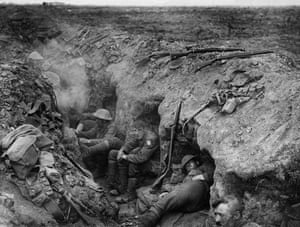
A century ago, European nations vented their aggression by making war, not playing football. The Battle of the Somme began on 1 July 1916 and lasted until mid-November; by the time it ended, more than a million soldiers were dead, probably including the Welsh Guards in this photograph, whose hapless task was to recapture the village of Guillemont from the industrialised German army with its howitzers, flamethrowers and big-bellied zeppelins.
These dispirited infantrymen hardly even have the luxury of a trench; they huddle in what looks like a gash left behind by a shell, and may have been told – as were many of their colleagues – to use clods of earth as camouflage, burying themselves alive. One of them, as blessedly indifferent to the chaos and carnage as The Good Soldier Švejk in Jaroslav Hašek’s novel, has left his rifle pointed at the sky and fallen asleep – unless, that is, he is actually dead. Another, his taut face hollowed by the memory of horrors, has the unfocused stare that was a symptom of shellshock. A third man, his jaw clamped shut on his misery, gazes at the photographer with numb stoicism.
But now the document turns crazily surreal, like the pointless war itself. The long-faced man has his hands crossed on three knees, and he seems, like a pantomime horse, to be the owner of the fourth leg cocked beside him. Is another soldier, also asleep or dead, stowed in the crypt-like foxhole behind him? Or do the extra limbs belong to a casualty whose upper half has been blown away? Is that grey, hovering cloud, behind which more figures are hidden, a souvenir of relaxing fag smoke, or of some other incineration? And do those abandoned knapsacks belong to corpses hauled out of sight of the camera?
In a terrain that was recently farmland and is now a butchered waste, the most depressing detail is the featureless, scrubby horizon. Painters like Turner and Constable lowered the skyline in their landscapes: earth mattered less than the spectacle of the air, where clouds represented the thoughts of God. Here the sky has been expunged, or reduced to a coffin lid that abruptly shuts on these subterranean men. In 1908, glorifying the sportive energy of combat, the Italian futurist Marinetti called war “the hygiene of the world”. This raw, messy photograph gives the lie to that loathsome notion: it exposes war as the defilement of the world, not its purification.
guardian.co.uk © Guardian News & Media Limited 2010
Published via the Guardian News Feed plugin for WordPress.

0 comments:
Post a Comment